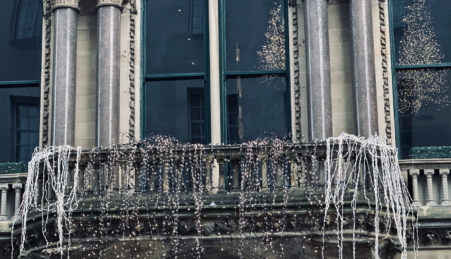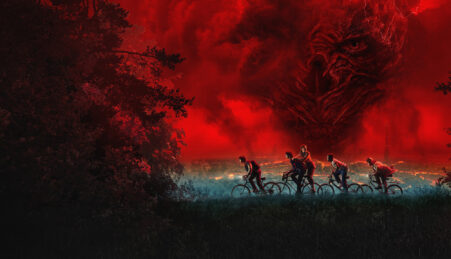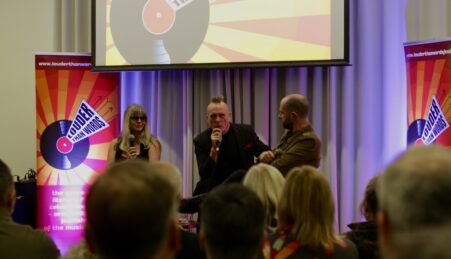
In the run up to Halloween, Humanity Hallows will be bringing you all the best action from the weekend’s Gothic Manchester Festival. First up we have this seriously spooky show from the festival’s opening night…
On Thursday night, a packed International Anthony Burgess Foundation hosted the opening event of the Gothic Manchester Festival as part of Humanities in Public (HiP). The hugely successful, sold-out evening, saw the spectacular venue’s Engine House brought to life by, firstly, a Gothic-themed talk by Dale Townshend, followed by a film screening of ‘Prepare to Enter the Phantasmagorical’ by David Annwn Jones.
Dr Linnie Blake, Principal Lecturer in Film in Manchester Metropolitan University’s Department of English and Director of the Manchester Centre for Gothic Studies, introduced the evening of gothic wonders and first speaker, Dale Townshend, Senior Lecturer in Gothic and Romantic Literature at the University of Stirling.

Dr Linnie Blake introduces the evening
Dale Townshend’s talk, entitled ‘Gothic Architecture, Gothic History, Gothic Romance and Kenilworth Castle, 1800 – 1830′ traced the origins of the Gothic and examined the relationships between the meanings of the term ‘Gothic’ via a reading of Ann Radcliffe’s ‘Gaston de Blondeville.’ Dale began by explaining,
“In an attempt to answer the question, ‘What is Gothic?’ we are faced with a broad and complex network of meanings and significations. A kind of over the tone combination of the term that not even the Oxford dictionary can really help us to untangle.
“As these various uses of the term show, Gothic has ranged over time to include such seemingly distant meanings as an Ancient Germanic tribe, an architectural style, a signifier of medieval, a style of print, a cultural lifestyle and a mode of expression. What I want to do in this talk is briefly address how some of these meanings of the term Gothic cohere, interact and come together in a relatively obscure fiction from the early nineteenth century.”
Next, David Annwn Jones, followed Dale’s talk with a mesmerising film screening of Prepare to Enter the Phantasmagorical. This film offers an authentic walk through tour of a phantasmagorical evening which haunted so many back in the original 1799 show.
David discovered the floor plan of the original convent used in the famous Phantasmagoria of E.A. Robinson and has since recreated it and transformed it into a vivid film. He explained how the “Phantasmagoria haunted the imaginations of Sheridan Le Fanu, Mary Shelley, Bram Stoker, and so many more writers.”
By walking the modern audience through the deserted convent he revealed how a Victorian audience would have been gripped and haunted by what they had experienced. He put the audience in the eighteenth century mindset – aiding our understanding of their fear and in turn the Victorian audience’s fascination.
We caught up with David and asked how he too first became enthralled in the subject, he told us,
“I’m a literature teacher and I have come across these references to phantasmagoria and I always was very curious about it. What was it? Why did writers, particularly Gothic writers, keep on mentioning it? When I found out about this ruined convent, I was a sucker for it! That was when I really had to find out all about it.” He went on to explain that, “people kept on telling me we will never, ever, ever recreate it because it was knocked down. It felt as though Robinson had been tapping on my shoulder and saying ‘look, look, that’s my convent’ and I thought ‘hold on, that’s it.’ It was almost as though he was physically there saying ‘look more closely, that’s where we were. Don’t listen to the other people.'”
David’s masterpiece is a reflection of his years of dedication and determination. The audience were then treated to a horror magic lantern show which was projected by a stunning authentic antique lantern. David presented a series of slides with some documenting the personalities of would-be attendees of an eighteenth-century phantasmagorical evening; from fashionable men seeking nice ladies to drunks looking to be spooked. This struck a chord with the varied audience in attendance – a group made up of researchers and lecturers, lovers of Literature, Gothic enthusiasts – people from all walks of life. That is was the beauty of this event and in fact, the entire Humanities in Public series. By opening up this research to beyond the realm of the University is both inclusive and inspirational.
Audience member, Victoria Priest, discussed her thoughts on the evening, saying, “It has broadened my horizons and it was a pleasure to attend and witness Dale and David’s work brought to life. The building added to the atmosphere and I have enjoyed the evening very much.”

David Annwn Jones
The talks closed with an energetic question and answer session as Dr Xavier Aldana Reyes from the Manchester Centre for Gothic Studies opened up the stage, giving the audience an opportunity to delve further into the research of the speakers. Reflecting on the evening, the Centre for Gothic Studies’ Dr Linnie Blake told us,
“It’s been a unique evening in that it has balanced an academic’s perspective on one of the key Gothic writers of the eighteenth century with another academic’s extremely entertaining and very engaging account of the public treatment of the phantasmagorical show that emerged in the 18th century, around the time of the French Revolution. These depicted horrors or mutilation and death to people who’d actually lived through the trauma of recent historical times.
“Even though I’m a Gothic Studies specialist, predominantly in film, I did not know anything about this – I did not know anything about people who had survived the French Revolution going to a show that was purposely designed to horrify and terrify them with pictures of recent historic carnage and I’m kind of disturbed by it. It seems a strange thing for traumatised revolution survivors to do but I’m also intrigued as to what they got out of it and what potential that had to heal them in some way.
“The Gothic is often thought of as a mode that looks at difficult political situations in a new way and enables them to engage with them. The whole event attracted a lot of members of the general public who are interested in the whole spectacle of the magic lantern. But it also provided them with some really interesting historical information, which most people, even Gothic specialists, don’t know about. So it was educational but also phenomenally entertaining and a real privilege to have the technology here to be able to show us.”
Dont forget to keep checking Humanity Hallows for more Gothic Goings-on…









No Comments
Manchester Gothic Festival 2014 – Day Two | The Blogging Goth